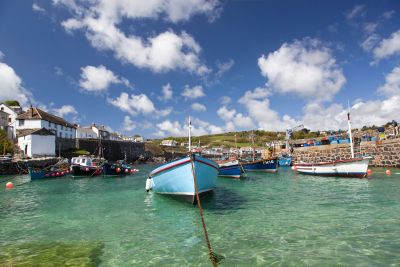
Coverack is a pretty fishing village tucked away in a sheltered bay on the eastern side of the Lizard Peninsula. Unsurprisingly, the main point of interest is the little harbour around which are a clutch of old cottages, some of which are thatched. The harbour was constructed in 1724 from local green serpentine and hornblende for the growing pilchard fleet that operated from here. The pilchard shoals are now gone but there are still a small number of little boats working from the harbour here.
Whilst the waters in the bay are relatively sheltered this coast is notorious for shipwrecks and nowhere more so than the Manacles reef a couple of miles along the coast. This barely submerged collection of rocks sits around a mile offshore and over the years has claimed more than 150 ships and countless lives.
It was in response to the loss of over 100 lives when the SS Mohegan hit the reef in 1898 that a lifeboat was stationed at Coverack. Much of the credit for this must go to the then vicar of St Keverne, Rev. William Diggins. A trip to the graveyard at St Keverne church will make it fairly obvious why he petitioned for the lifeboat here.
The all-weather lifeboat service remained until 1972 with duties now covered by the Lizard and Falmouth lifeboats. These days the old lifeboat house serves as a fish and chip shop overlooking the harbour.
The village's main inn is also testimony to this dangerous coast. The Paris Hotel is named after an American liner which hit the rocks off Lowland Point in 1899. Fortunately in this case there was no loss of life and the story goes that some parts of the salvaged ship now form parts of the hotel's interior. Whatever the case, the Paris is a great spot to sit out in the sun watching life go by.
Coverack is a popular holiday location for obvious reasons. There is a pleasant beach here with plenty of sand at lower tides. The shelter of the bay also makes it a great spot for watersports with windsurfing particularly popular here. Coverack bay is also a safe anchorage for yachts and pleasure craft in most conditions.
Visitors are well catered for with a range of accommodation including the nearby YHA hostel. There are also a choice of cafes, pubs and restaurants dotted along the village's lengthy sea front.
Set overlooking the bay is the small church of St Peter. Built in 1885 its most interesting features are the serpentine pulpit, donated by the old serpentine factory at Poltesco and stained glass windows depicting St Keverne and St Peter.
With the beautiful coastline of the Lizard Peninsula stretching out in both directions Coverack is a great starting point for walking. Both directions are Sites of Special Scientific Interest (SSSIs) owing to the unique geology of the Lizard. As you walk the coast path here every corner will reveal hidden coves and rugged headlands such as Chynalls Point with its Iron Age cliff fort.
Despite much of the old industry having gone Coverack still has an active community with a variety of events going on throughout the year. There is a regatta, Lifeboat Day and the traditional Christmas Day swim. This charity event dates back 50 years with brave locals and visitors alike taking a dip in the harbour.
















